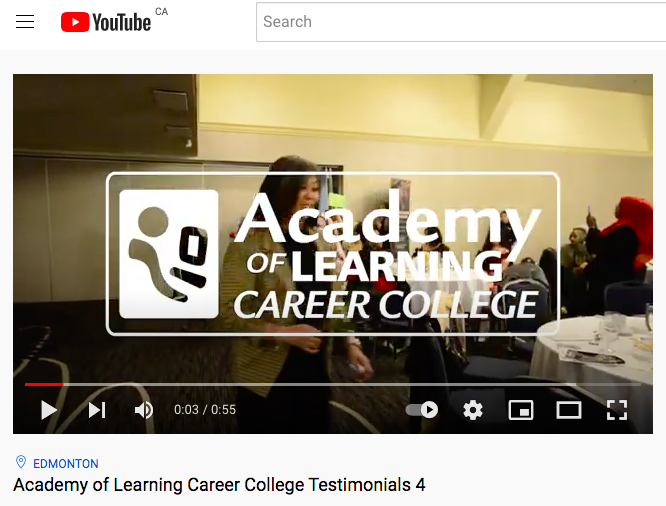Student testimonials should be at the top of your school’s content creation list. Information about what kinds of students have enrolled at your institution, the types of careers they choose to pursue and how your school helped them on their path is essential for the “good fit” feeling that will turn prospects into enrolled students. Testimonials are all about story-telling, allowing institutions to share their students’ paths in a way that is both unique and general. What’s more, they improve the “trustworthiness factor” of your institution, as students have access to real feedback from those who were once in their position.
While testimonials are highly influential in the student recruitment process, there are a few steps that your school can take in order to take full advantage of their powerful potential. Remember, getting prospective students to notice the testimonials in the first place involves optimizing your institution’s digital and social media presence. Read on to discover four different ways to tell your current and former students’ stories.

1. Create Compelling Videos as a Component of Social Media for Schools
One of the best ways to effectively showcase student testimonials is by creating videos of students sharing their stories. Videos can be impactful, allowing prospects to develop a deeper connection to your institution by watching students speak about their experiences firsthand. Often used as a component of social media marketing for schools, integrating these videos into your recruitment strategy can go a long way in driving leads. Below, explore some steps to creating videos of student testimonials.
- Before shooting, draft a list of testimonials you would like to create. They should cater to the various categories of students attending your school: full-time students, working students, returning students, etc. Use the reviews written by your students to find common themes. You can also conduct a student poll about the services and programs that won them over when deciding which school to study at.
- Determine the format of your testimonial videos: think about the feel of the video and the message you want viewers to take away. If necessary, draft a quick storyboard for the shooting team to follow. Depending on the purpose of the video, the featured stories should include:
-
- Student anecdotes about why they chose your school
- Student’s future goals post-graduation
- How your school will help them reach this goal
- What made your school stand out
- What their life path was before becoming a student at your school
- Show your school’s premises
- Many students will look at your videos from their smartphones and long uploads could discourage some of them so make sure all videos last less than 1 minute.
- Let the student talk freely. There is nothing worse than scripted testimonials.
- Run the video with your marketing department to make sure it is consistent with the vision of the school.
- Integrate these videos on strategic points of your school’s website: website homepage, program homepage, next to a Request Information form, etc.
- Share these videos through social media.
For example, Academy of Learning Career College has displayed a series of student testimonials on their YouTube channel, sharing various student success stories.

2. Host Student Blogs
Student blogs are ongoing, real-time testimonials about a student’s experience at your school. Because it stems from peers and not from marketing departments, information on these blogs is more authentic and therefore, interesting for prospects. If your school already has a blog, integrating one or two posts per week featuring students \can go a long way in educating prospective students about what it’s really like to attend your institution.
For example, Algonquin Careers Academy regularly profiles students in their blog, sharing information valuable to students looking for more information about a certain program or career path.

Discover more about the impact that student testimonials can have on your student recruitment strategy here.
Another example is the University of Victoria asking prospects to get in touch with their student bloggers. The university has a page dedicated to student bloggers and student life.


3. Maintain an Active Presence on Social Media
Your presence on social media platforms is a great indication of how your students feel about your school. A Facebook page with few shares and comments or a Twitter account with only a few followers will make it seem like your students aren’t passionate about the education they’ve received at your institution. Student engagement is a great testimonial in itself, and by taking a few steps, you can ensure that your institution is maintaining the right kind of presence on social media.
For one, it’s important that you pick the right platforms for your school. As a general rule of thumb, you’ll want to question the relevance of platforms with little to no engagement. In reality, the most effective social media platforms for schools are usually the ones used by students. Today, many universities are building their social media presence on TikTok and Snapchat, both platforms which are used extensively by their prospective student pool that many institutions are trying to target. For example, shown below, the Rochester Institute of Technology has built a strong presence on TikTok, with consistent videos showcasing student activities.

Source: @RITigers on TikTok
Many institutions are finding that the short, mobile-compatible videos on TikTok and Snapchat are fostering higher levels of engagement. However, social media can also be used to capture audiences in different ways. Picture tagging, quizzes and polls, and media showing student life on campus all contribute to generating recruitment leads. What’s more, when you include a variety of information about your institution, students and life on campus on social media platforms, engagement amongst prospective students will grow.
4. Foster Your School’s LinkedIn Network
In terms of social media for schools, LinkedIn is among the most important places to build trust among prospective students. The quality of the network provided by your school upon graduation also says a lot about your school, its students’ attachment to it and its credibility on the labour market.
Make sure your website features an Alumni section that fully describes the depth of the network and activities. For example, John Cabot University has a section dedicated to Alumni News.

You can also communicate (in videos!) about the link between your alumni and students. As prospective students might already know, mentorship is a great asset when starting a career or switching careers.
Although Alumni are usually a separate entity from schools, make sure your Alumni are present and active on LinkedIn. Try to ensure that the groups are active, and do everything to help students publicize their profiles and advance their careers.
An important additional note: just as it is important to create positive and genuine student-generated testimonials, it is crucial to monitor the unsolicited, negative testimonials. With most of your students on social media, it is paramount to react quickly to what is being said about your school across platforms. Great listening tools exist to do just that. React quickly to manage your reputation and limit any damage to your school’s brand.
Creating powerful student testimonials, nurturing your alumni network, and highlighting each on the right platforms can go a long way in boosting your student recruitment strategy. When you’re able to showcase what students have to say about your institution, prospective students will be more inclined to trust the value of your school and move forward in the admissions process.







